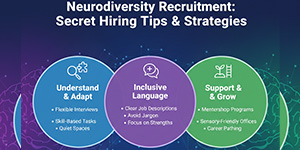Generational Diversity in the Workplace: Strategies for Inclusion
The modern workplace is more diverse than ever, with employees from different generations working side by side. From Baby Boomers and Generation X to Millennials and Gen Z, each group brings unique experiences, values, and communication styles to the table.
This article explores strategies for fostering generational diversity in the workplace, enhancing generational collaboration, and ensuring workplace flexibility for all ages.
Understanding Generational Diversity in the Workplace
What is Generational Diversity?
Generational diversity in the workplace refers to the presence of multiple age groups within an organization. Each generation has distinct values, work ethics, and expectations shaped by their life experiences. Understanding these differences is crucial for managing multigenerational teams effectively.
The five primary generations in today’s workforce include:
• Traditionalists (born before 1945) – Value loyalty and discipline.
• Baby Boomers (1946-1964) – Prefer a structured work environment and personal interaction.
• Generation X (1965-1980) – Independent, self-sufficient, and adaptable to change.
• Millennials (1981-1996) – Value collaboration, flexibility, and technology-driven solutions.
• Gen Z (1997-2012) – Prioritize digital communication, diversity, and work-life balance.
The Benefits of Generational Diversity
A diverse workforce offers multiple benefits, including:
• Innovation – Different perspectives lead to creative problem-solving.
• Knowledge Transfer – Older employees share experience, while younger ones bring fresh ideas.
• Stronger Workplace Culture – An inclusive workplace culture fosters collaboration and mutual respect.
Managing Multigenerational Teams Effectively
1. Encourage Generational Collaboration
Fostering a culture of teamwork among different age groups enhances workplace diversity and inclusion. Organizations should:
• Promote mentorship programs – Pair Baby Boomers or Gen X employees with Millennials and Gen Z workers for knowledge-sharing.
• Encourage cross-generational projects – Collaboration across different age groups promotes learning and innovation.
2. Adapt Generational Communication Styles
Each generation prefers different modes of communication:
• Baby Boomers & Gen X – Favor face-to-face meetings and phone calls.
• Millennials & Gen Z – Prefer instant messaging, emails, and collaboration tools like Slack.
To bridge the communication gap, companies should offer a mix of communication channels, ensuring everyone feels heard and valued.
3. Foster an Inclusive Workplace Culture
An inclusive workplace culture respects all employees, regardless of age. Strategies include:
• Eliminating age-based stereotypes – Avoid assumptions like “older employees resist technology” or “younger workers lack commitment.”
• Offering unbiased career advancement – Promotions and opportunities should be based on merit, not age.
• Encouraging open dialogue – Creating an environment where employees can express concerns and share feedback.
Workplace Flexibility for All Ages
1. Customizing Work Arrangements
Generational work preferences vary, so providing flexibility is essential. Some key strategies include:
• Remote work options – Millennials and Gen Z highly value flexibility, while older generations may prefer office-based work.
• Flexible hours – Baby Boomers may appreciate reduced hours or phased retirement plans.
• Job-sharing and compressed workweeks – Help accommodate diverse needs.
2. Addressing Generational Learning Styles
Employees from different generations have varied learning preferences:
• Baby Boomers & Gen X – Prefer traditional training sessions, workshops, and manuals.
• Millennials & Gen Z – Favor interactive e-learning, video tutorials, and mobile-based learning.
Organizations should offer multiple training formats to cater to these generational learning styles.
Read More: How to Increase Diversity in the Workplace
Generational Leadership Styles
Leaders should be adaptable in their approach when managing multigenerational teams.
1. Transformational Leadership for Younger Generations
Millennials and Gen Z respond well to transformational leadership, which focuses on innovation, teamwork, and personal growth. These generations thrive under leaders who:
• Provide regular feedback and career development opportunities.
• Encourage collaboration and open discussions.
2. Directive Leadership for Older Generations
Baby Boomers and some Gen X employees may prefer a more structured, directive leadership style that emphasizes clear expectations and goals. These employees often value:
• Stability and long-term vision.
• Well-defined hierarchies and leadership structures.
3. Blended Leadership Styles
The best leaders adapt their leadership styles to accommodate all age groups, balancing structure with flexibility and guidance with autonomy.
Overcoming Challenges in Generational Diversity
While generational diversity in the workplace offers many benefits, it also presents challenges. Some common issues include:
1. Resolving Conflict Between Generations
Conflicts may arise due to different work ethics, values, or communication styles. Organizations can mitigate this by:
• Encouraging open dialogue – Regular meetings and team discussions allow employees to express concerns.
• Providing mediation training – Equip managers with conflict resolution skills to address intergenerational disputes.
2. Bridging the Digital Divide
Younger employees are digital natives, while older employees may not be as comfortable with technology. To address this:
• Offer digital training programs – Help employees upskill in modern workplace technology.
• Foster a culture of mutual learning – Encourage younger employees to mentor older colleagues in tech skills.
3. Retaining and Motivating Employees Across Generations
Different generations have varying motivations for job satisfaction:
• Baby Boomers & Gen X – Seek stability, recognition, and retirement benefits.
• Millennials & Gen Z – Value purpose-driven work, professional growth, and work-life balance.
To retain employees, organizations should provide tailored benefits and career paths that cater to these diverse needs.
Conclusion
Successfully managing multigenerational teams requires a deep understanding of generational differences at work. By fostering an inclusive workplace culture, encouraging generational collaboration, and embracing workplace flexibility for all ages, organizations can unlock the full potential of their diverse workforce.
Leaders should focus on balancing generational communication styles, addressing generational work preferences, and implementing adaptive generational leadership styles. By doing so, they can create a workplace where employees of all ages thrive, collaborate, and contribute to the organization's success.
Read More: How Many Hours Per Week Should You Work on Average





